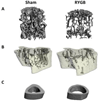Cortical and trabecular deterioration in mouse models of Roux-en-Y gastric bypass
- PMID: 26806052
- PMCID: PMC4792678
- DOI: 10.1016/j.bone.2016.01.017
Cortical and trabecular deterioration in mouse models of Roux-en-Y gastric bypass
Abstract
Roux-en-Y gastric bypass (RYGB) is a profoundly effective treatment for severe obesity, but results in significant bone loss in patients. Developing a murine model that recapitulates this skeletal phenotype will provide a robust tool with which to study the physiologic mechanisms of this bone loss. We studied adult male C57BL/6J mice who underwent either RYGB or sham operation. Twelve weeks after surgery, we characterized biochemical bone markers (parathyroid hormone, PTH; C-telopeptide, CTX; and type 1 procollagen, P1NP) and bone microarchitectural parameters as measured by microcomputed tomography. RYGB-treated mice had significant trabecular and cortical bone deficits compared with sham-operated controls. Although adjustment for final body weight eliminated observed cortical differences, the trabecular bone volume fraction remained significantly lower in RYGB mice even after weight adjustment. PTH levels were similar between groups, but RYGB mice had significantly higher indices of bone turnover than sham controls. These data demonstrate that murine models of RYGB recapitulate patterns of bone loss and turnover that have been observed in human clinical studies. Future studies that exploit this murine model will help delineate the alterations in bone metabolism and mechanisms of bone loss after RYGB.
Keywords: Bariatric surgery; Bone loss; Bone microarchitecture; Gastric bypass; Mouse models; Obesity; Weight loss.
Copyright © 2016 Elsevier Inc. All rights reserved.
Figures



References
-
- Fryar CD, Carroll MD, Ogden CL. Prevalence of Overweight, Obesity, and Extreme Obesity Among Adults: United States, Trends 1960–1962 Through 2009–2010. 2012 In.
-
- Buchwald H, Oien DM. Metabolic/Bariatric Surgery Worldwide 2011. Obesity Surgery. 2013;23:427–436. - PubMed
-
- Carrasco F, Ruz M, Rojas P, Csendes A, Rebolledo A, Codoceo J, Inostroza J, Basfi-Fer K, Papapietro K, Rojas J, Pizarro F, Olivares M. Changes in Bone Mineral Density, Body Composition and Adiponectin Levels in Morbidly Obese Patients after Bariatric Surgery. OBES SURG. 2009;19:41–46. - PubMed
Publication types
MeSH terms
Substances
Grants and funding
LinkOut - more resources
Full Text Sources
Other Literature Sources
Research Materials

